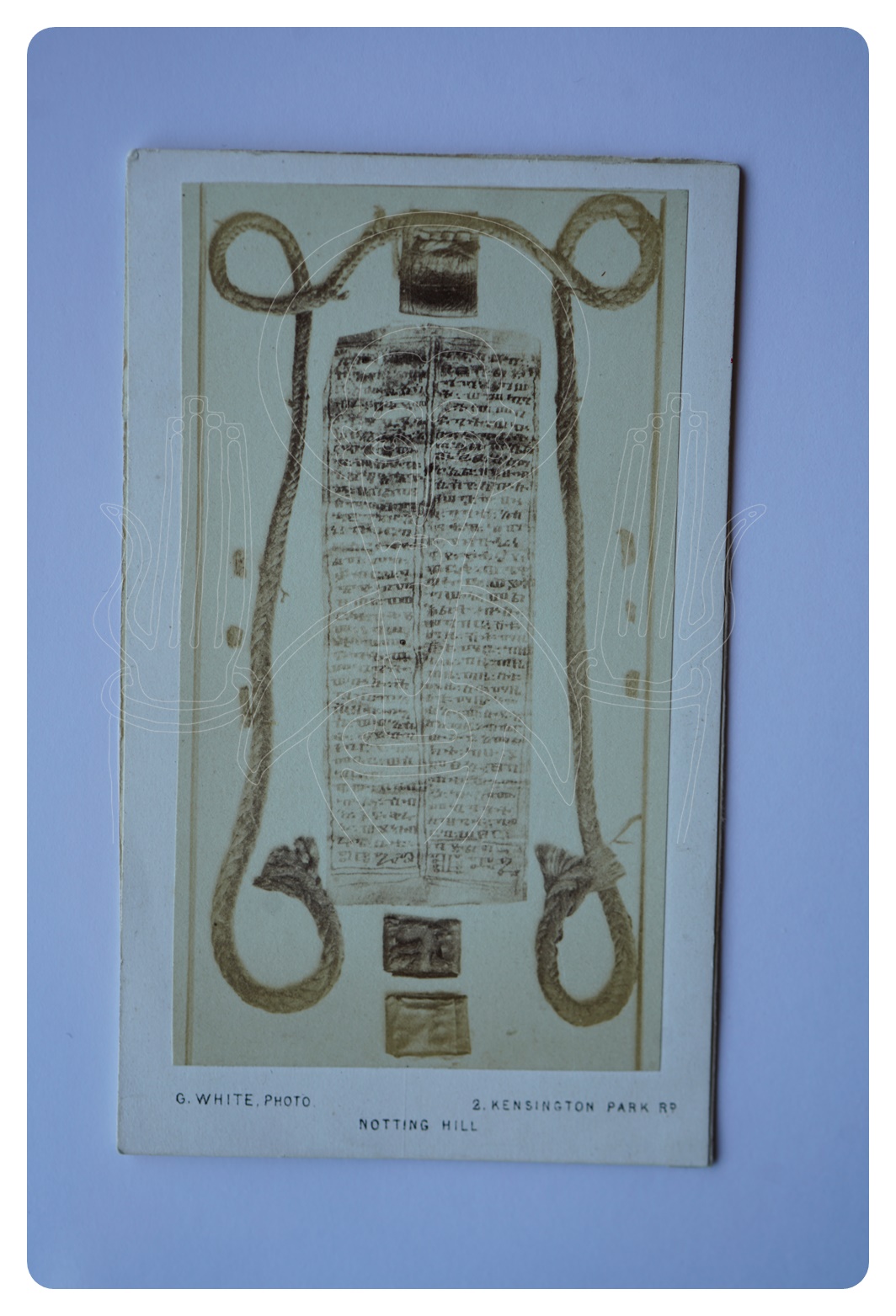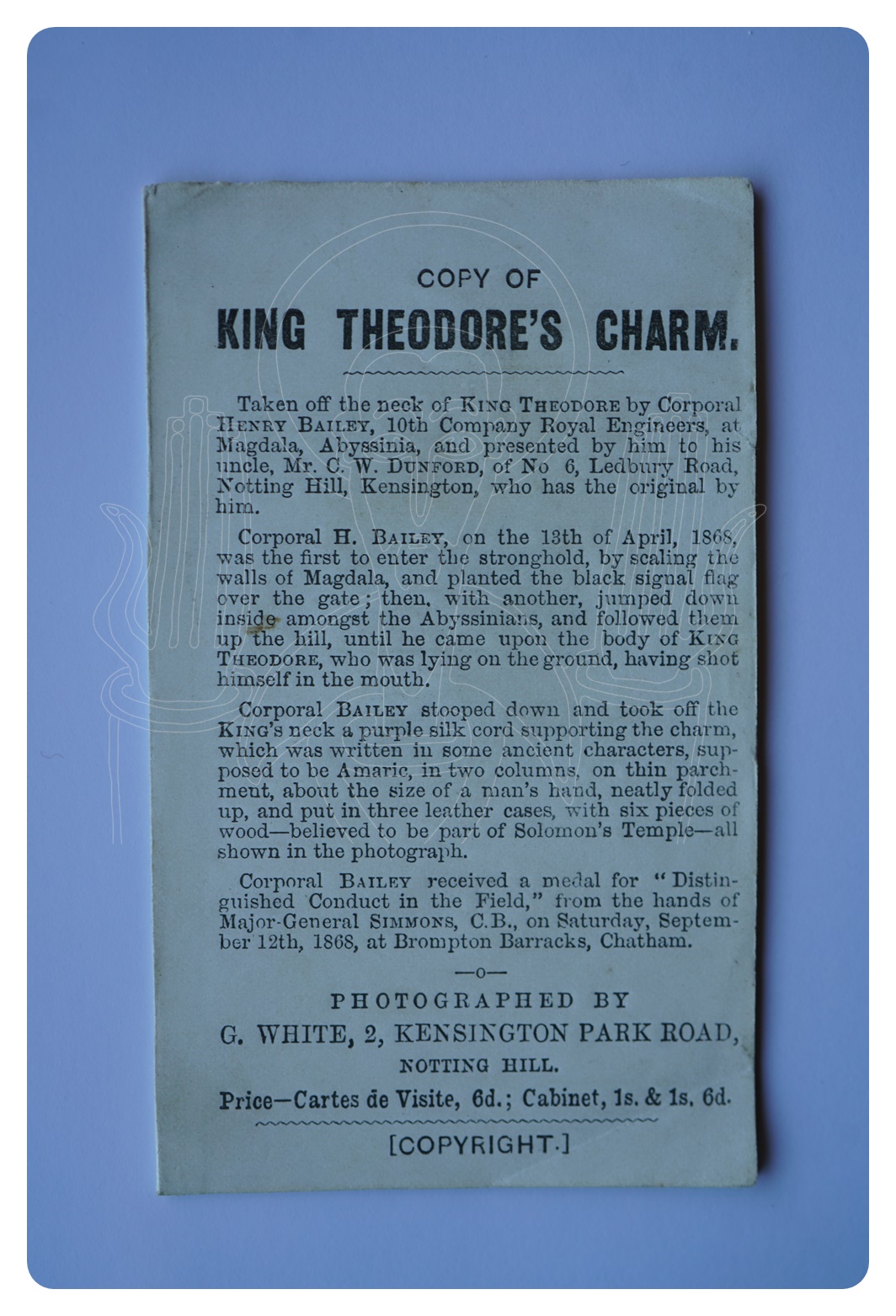King Theodore’s Charm.



Édition
Éditeur : G. White
Lieu : Notting Hill
Année : s.d.
Description
État du document : bon
Références
Réf. Biblethiophile : 004531
Réf. UGS : 4120000
COLLATION :
CDV en bon état, légende au dos.
En savoir plus
Selon la légende au verso de cette carte de visite, l’amulette du negusä nägäst Tewodros II fut volée sur le corps du défunt par le caporal Henry Bailey et emportée en Angleterre. Elle entre dans la liste des biens éthiopiens pillés par l’armée britannique lors de l’expédition de 1868.
COPY OF KING THEODORE’S CHARM.
Taken off the neck of King Theodore by Corporal Henry Bailey, 10th Company Royal Engineers, at Magdala, Abyssinia, and presented by him to his uncle, Mr. C. W. Dunford, of No 6, Ledbury Road, Notting Hill, Kensington, who has the original by him.
Corporal H. Bailey, on the 13th of April, 1868, was the first to enter the stronghold, by scaling the walls of Magdala, and planted the black signal flag over the gate; then, with another, jumped down inside amongst the Abyssinians, and followed them up the hill, until he came upon the body of King Theodore, who was lying on the ground, having shot himself in the mouth.
Corporal Bailey stooped down and took off the King’s neck a purple silk cord supporting the charm, which was written in some ancient characters, supposed to be Amaric, in two columns, on thin parchment, about the size of a man’s hand, neatly folded up, and put in three leather cases, with six pieces of wood—believed to be part of Solomon’s Temple—all shown in the photograph.
Corporal Bailey received a medal for “Distinguished Conduct in the Field, » from the hands of Major-General Simmons, C.B., on Saturday, September 12th, 1868, at Brompton Barracks, Chatham.
PHOTOGRAPHED BY G. WHITE, 2, KENSINGTON PARK ROAD, NOTTING HILL. Price – Cartes de Visite, 6d. ; Cabinet, 1s. & 1s. 6d.
[COPYRIGHT.].
La polémique concernant les biens éthiopiens par les armées britanniques et italiennes est on ne peut plus d’actualité. De manière plus générale, elle s’inscrit dans la réflexion que les musées, tout particulièrement européens, doivent mener. Sans entrer dans le fond et en considérant le patrimoine éthiopien, le British Museum, entre autres, est au centre de l’attention car il détient une partie du butin de l’expédition de Lord Napier. Pour inciter à réagir concrètement, l’AFROMET (Association For the Return of the Magdala Ethiopian Treasures)[1] a été créée à Addis-Abéba, il y a déjà un quart de siècle. Hormis quelques résultats spectaculaires, les résultats sont de l’avis de certains trop maigres. Ils ont tout du moins contribué à une prise de conscience de l’opinion publique.
Qu’en est-il de l’amulette de Thewodros II ?
En 1962, Richard Pankhurst dévoile l’existence du phylactère dans une note[2], illustré d’une photo de l’artefact, légèrement différente de la carte de visite de la collection biblethiophile qu’il ne semble pas connaître. Il donne une traduction du texte en geez :
« The prayer that God gave to Moses, his servant, before the king Pharaoh:
(Tse) felshu Anahor Tsimur (or Dimur) Mahtsun Ilshai’ pion.
I, thy servant Sertse Dengel, fall upon thee that, by the authority of thy name, thou may enlighten my face (personality) like the sun and the moon in the presence of kings, highnesses, excellencies and all people, men and women. Let my speech be as sweet as honey, sugar and salt to all people, so that all kings, excellencies, highnesses and all living creatures may love and respect this servant of thine: Sertse Dengel.»
Le phylactère royal réapparaît en 2002 selon l’article que lui consacre Hailu Habtu[3]. On y apprend que sa restitution à l’Institute of Ethiopian Studies par un Britannique resté anonyme est le fait de l’AFROMET et que Richard Pankhurst a l’honneur de ramener personnellement en Éthiopie. L’auteur de l’article développe la signification des phylactères en Éthiopie en s’appuyant sur les travaux de Sylvain Grébaut et Deborah Lifchitz. Il donne une traduction du texte en geez :
« The prayer that God gave to Moses, his servant, in the presence of Pharaoh the king.
Defereshu, ananar, dimun, me’arn, alda’e, Tsio.
By the poyer of Your name, I beg You, [I] Your servant Sertse Dingel that You may turn my face radiant like the sun and the moon in the presence of kings, princes, nobles, and all people, and all heathen, all men, and all women. And that my speech may be like honey and sugar, and like salt with all people. May all persons love me and honor me, I, Your servant Sertse Dingel: kings, nobles, princes, and all creatures. Téel, Téel, Téel, AAmannuel, who gives bounty to all [made] of flesh. By power of these Your names, May they [Your names] give me good things: gold, treasures, and silver. And may they enthrone me above all thrones. Shitumaze, Kezibaze, Keziteze, Teze, Taze, Letumaze, Letumaze, Letumaze, As the mighty and the princes give [unto the Lord glory and praise] may all the nobles and officials bring offerings and tribute to the servant of Yours, Sertse Dingel. »
En 2005, la liste des biens spoliés restitués se résume à dix biens[4]. Qu’en est-il en 2024 et que peut-on espérer de l’avenir ?
Biblethiophile, 16.08.2024
[1] https://en.wikipedia.org/wiki/Association_For_the_Return_of_the_Magdala_Ethiopian_Treasures, consultée le 15.08.2024. On notera que le lien vers du site officiel d’Afromet et vers les deux articles de Richard Pankhurst n’aboutissent pas.
[2] PANKHURST (Richard), The Emperor Theodore’s Amulet, in Ethiopia Observer, vol VI, No. 3, p. 291, version en ligne https://babel.hathitrust.org/cgi/pt?id=inu.32000013024981&seq=11, consultée le 16.08.2024.
[3] HAILI HABTU, The Amulet of Emperor Theodore, in Annales d’Ethiopie, vol XIX, 2003, p. 257-263.
[4] Angola Press, 28 octobre 2005, https://www.elginism.com/similar-cases/ethiopia-recovers-more-looted-artefacts/20051028/248/, consultée le 15.08.2024.